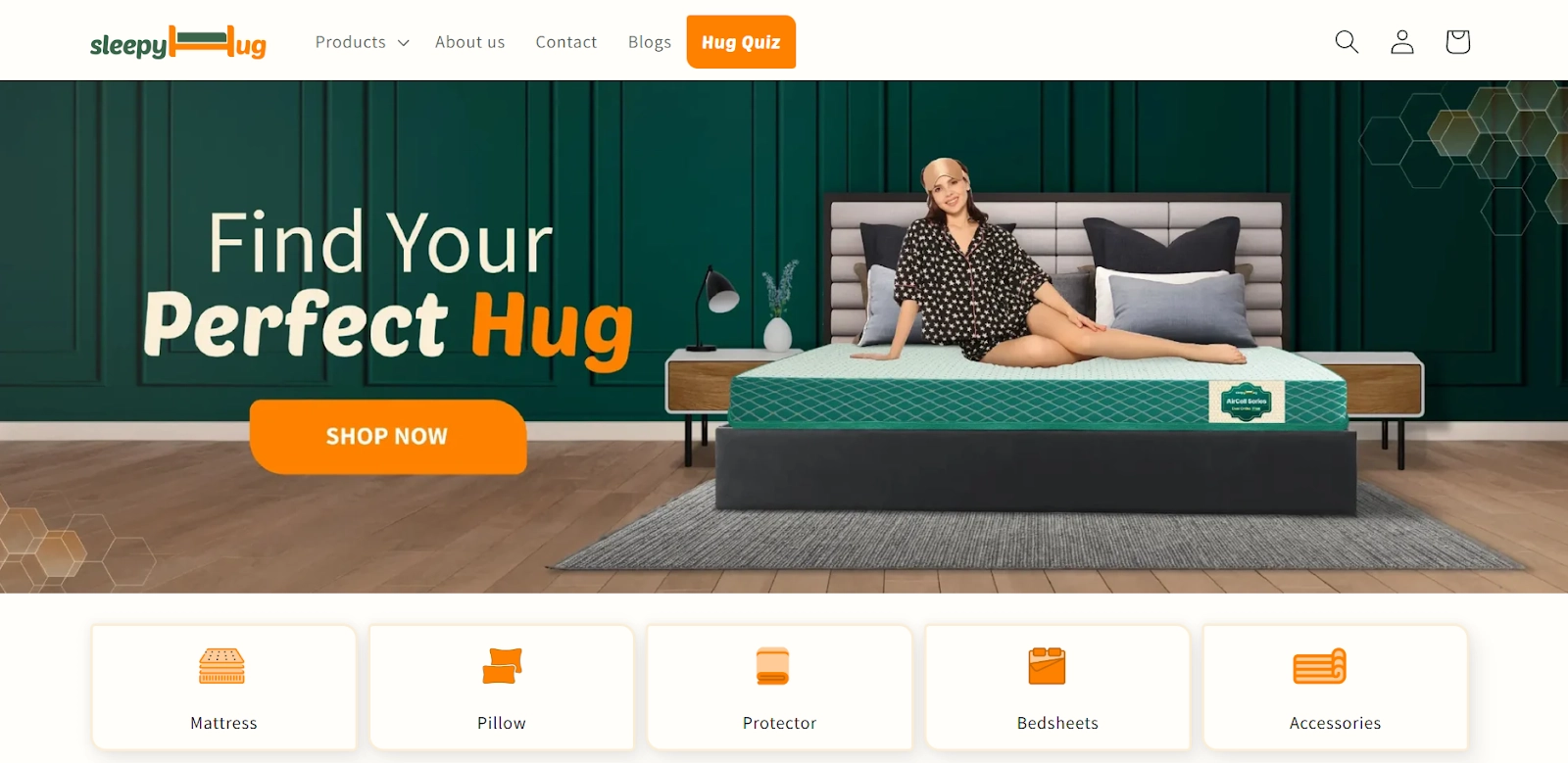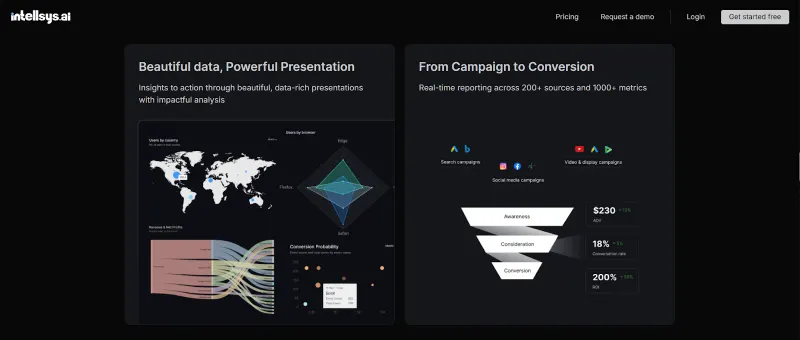SleepyHug’s Revenue Strategy for Explosive ARR Growth

Startup mattress companies in a populated country get stuck between big names with high prices and the same fancy-named memory foam tactics by D2C brands.
Customers are left to choose between back pain and EMIs for mattresses. There was no wellness-first approach, which is why recurring revenue was unheard of in a category where people can only afford one-time purchases.
GrowthJockey wanted to change that and revolutionise annual recurring revenue (ARR) for the mattress industry.
So SleepyHug, a sleep wellness brand, took this opportunity and, with GrowthJockey’s help, built a ₹100 CR ARR strategy in just 13 months by integrating real-time analytics, demand forecasting, and performance-driven GTM execution.
From CAC discipline with intelligent platforms to SKU-level profitability, SleepyHug engineered a predictable, recurring revenue model in a category where that felt impossible. If you want to find out how, this case study will break down all the nitty-gritties of their strategy.
What counts as annual recurring revenue in SleepyHug’s model
In most e-commerce setups, ARR is rare and often a stretch. Unless you’re selling subscriptions like beauty boxes or grocery deliveries, ARR typically includes repeat purchase cycles, subscriptions (if any), and memberships.
For most product-led D2C brands, revenue is a questionable matter driven by promotions, seasons, or new launches, which is not a reliable, recurring stream.
The team found that the e-commerce subscription market size grew from $326 billion in 2024 to $539 billion in 2025[1], reflecting an astonishing 65% year-over-year growth.
After further research, it was revealed that the growth was attributed to convenience, personalisation, exploration, loyalty, and retention. SleepyHug leveraged this information and applied it to a category that had never seen it before.
How did SleepyHug apply ARR to their mattresses?
Instead of chasing only one-time sales of high-ticket mattresses, the brand engineered recurring revenue by segmenting its portfolio into three predictable streams:
- Mattress subscriptions: A quarterly/annual plan offering replacements, upgrades, or trial-based financing.
- Add-on accessories: Pillows, protectors, and linens bundled as part of auto-renewing care kits.
- Service plans: Including warranty extensions, sleep concierge consults, and maintenance support.
They discarded deep-discounted festival sales, clearance SKUs, or one-off combos that don’t show repeat purchase potential from the strategy.
In short, SleepyHug’s ARR wasn’t just maths, it was intent. So, before you can build a revenue engine, you need clarity on what counts as annual recurring revenue in your model.

How SleepyHug managed the ₹0 to ₹100CR ARR leap
As we saw, most D2C brands chase growth through flashy campaigns or discount-driven spikes. SleepyHug took a more calculated route by designing revenue streams that were predictable, measurable, and repeatable.
From pricing experiments to churn-aware forecasting and cash-conscious reinvestment, here's how it built a growth engine that scaled and sustained.
1. Building a revenue model for e‑commerce startups
SleepyHug’s approach offers a guide for any founder designing a recurring-first revenue model in e‑commerce, one rooted in predictability, not guesswork.
In the early months, the team maintained a lean marketing budget of ₹1.3 lakh. They relied heavily on SEO, content marketing, and organic referrals as part of Sleepyhug’s go-to-market strategy.
Testing: As the brand gained traction, it gradually scaled spend to ₹11–14.5 lakh/month. But only after running small tests to see what converted well.
Expanded SKU: Its pricing and bundling strategy were central to growth. SleepyHug expanded from 39 to over 500 stock-keeping units (SKUs), allowing cross-selling of accessories like pillows and linens.
Pricing strategies: By offering bundle discounts and surfacing accessories at checkout, it increased average order value. And created follow-up touchpoints for future sales.
While the brand didn’t offer classic subscriptions, it created repeatability through adjacent product categories and limited-edition SKUs like mood-enhanced mattresses.
Mattress customers were re-engaged via email. They added offers on pillows, bedsheets, and dual-sided upgrades. This extended customer lifetime value (LTV), without deep discounts.
2. Testing price points via A/B on Flipkart
SleepyHug used Flipkart as its testing ground for pricing validation. Using Intellsys.ai, an intelligent data management platform’s real-time pricing engine, the team tracked over 22,000 SKUs and compared SleepyHug’s prices with competitors in real time.
This allowed:
- A/B tests across ₹100-₹300 price windows
- Conversion-rate optimisation per SKU
- Margin tuning before scaling to other platforms like Amazon or D2C
Winners from Flipkart tests were rolled out more widely, while non-performers were paused or reworked, ensuring pricing remained both competitive and profitable.
3. Forecasting net ARR with Intellsys.ai
SleepyHug tracked net ARR, not just top-line run rate. This meant factoring in returns, platform commissions, and churned sales to arrive at a realistic recurring revenue base.
The calculation followed:
Net ARR = Gross ARR - (Churned MRR × 12)
Using intellsys, SleepyHug monitored over 1,000 metrics from SKU-level sales velocity to DRR deal run rate (DRR), inventory risk, and ad-to-sales lag. This gave the team real-time forecasts of monthly and annual revenue, demand surges, and margin zones.

These insights helped with:
- Inventory planning before peak events
- Category-wise growth bets (e.g., MoodPlay fabrics)
- And pricing elasticity tests for new launches
4. Strategic revenue management tactics
Dynamic pricing and smarter channel allocation were part of a broader strategic revenue management approach tailored for margin protection. Let’s take a look at how the rebalancing protected ARR margins while avoiding overreliance on short-term paid traffic.
Dynamic pricing
With intellsys, prices were adjusted in real-time based on inventory turnover, warehouse congestion, and competitor benchmarks. Older SKUs nearing overstock were priced to clear. Fast-moving variants had premium prices during festive periods.
Channel mix optimisation
SleepyHug faced a paid-to-organic ratio breach in May-June, when performance marketing costs surged and organic sales dropped to 50%.
The team paused ad-heavy campaigns, refreshed SEO content, and leaned on referrals and UGC to restore organic contribution to 80%, while keeping customer cost acquisition (CAC) within target.
5. Profit booking strategy to support cash flow and ARR margin
Rather than chasing growth at any cost, SleepyHug adopted a margin-first cash flow strategy:
- Promotions were tightly controlled: Discounting was limited to new product launches, not mass-sale events.
- Marketing was capped at 3-5% of revenue: Tracked via Total Advertising Cost of Sale (TACOS), not platform-optimised ACOS.
- A fixed percentage of ARR was reinvested: New investments were for R&D (e.g., scent-infused fabrics, foldable mattresses), logistics upgrades (e.g., expanding to 6 regional warehouses), and customer service infrastructure (e.g., multilingual chatbots, 24/7 support).
The result was a brand that scaled without cash burn, preserved per-unit profitability, and compounded trust alongside revenue.
Measuring and optimising annual recurring revenue metrics
If you're as serious about scaling ARR as Sleepyhug, you can’t just track revenue. You need to understand what’s behind it. That means building a habit of measuring the three metrics most D2C founders overlook:
- CAC
- LTV:CAC ratio
- Churn rate
SleepyHug’s extra measures for achieving ₹100CR ARR
At SleepyHug, the above metrics were monitored weekly rather than quarterly, using real-time dashboards. This lets the team spot CAC spikes early (like when paid ads overtook organic sales in mid-2024), adjust budget allocation, and keep unit economics healthy even while scaling fast.
They also ran cohort analyses to track how different customer groups performed over time, revealing which triggers drove repeat purchases, referrals, or drop-offs. The data led to better retargeting, smarter bundling, and more profitable retention flows.
If you’re building a consumer brand and don’t yet have this feedback loop in place, GrowthJockey’s venture studio model is built to plug that gap. With access to growth dashboards, cohort engines, and seasoned PMs, you get to scale like SleepyHug without flying blind.
Founder insights: Lessons learned and key takeaways
If there's one thing SleepyHug proves, it's this: scaling revenue is easier when you stop chasing the wrong metrics.
Too many brands obsess over gross revenue, only to use up all their cash because their retention is weak or CAC is bloated.
Application: SleepyHug embedded data loops early across marketing, operations, and product.
Lesson: Real-time dashboards gave the team visibility into what was working (and what wasn’t) long before it showed up in bank statements.
Application: One key decision was to focus on net annual recurring revenue, not vanity top-line run rates. The team subtracted churned MRR and platform returns to understand the actual health of the business and made forecasts accordingly.
Lesson: This clarity helped them tweak pricing, invest confidently in inventory, and avoid short-term growth traps.
For founders building in any D2C category, the takeaway is clear: build for compounding, not spikes.
This disciplined profit-booking strategy helped SleepyHug scale ARR without compromising on cash flow or unit economics. Start tracking what matters early, and if you don’t know where to begin, GrowthJockey as a business accelerator gives you the tools and team to do exactly that, just like they did for SleepyHug.
FAQs about annual recurring revenue (ARR)
1. How to calculate annual recurring revenue?
ARR is calculated by multiplying the monthly recurring revenue (MRR) by 12. For example, if a customer pays ₹5,000/month for a subscription, that equals ₹60,000 ARR. Only predictable, recurring revenue streams are included; no one-time sales.
2. What is the meaning of 1M ARR?
1M ARR means the business earns ₹1 crore (₹10 million) in predictable, annualised recurring revenue. It’s a key metric for subscription or repeat-purchase businesses and signals financial traction, especially in early-stage funding or investor conversations.
3. What is the difference between ACV and ARR?
ARR tracks how much recurring revenue a company earns annually. ACV (Annual Contract Value) refers to the average value of a single customer contract over a year. ARR is about total revenue; ACV is per customer.
4. What is the difference between annual recurring revenue and profit?
ARR is the total predictable revenue from subscriptions or repeat sales in a year. Profit is what’s left after subtracting all costs, like manufacturing, marketing, and operations, from revenue. A company can have high ARR and still be unprofitable.








